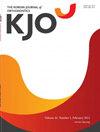变形链球菌和牙龈卟啉单胞菌在正畸托槽原料唾液源生物膜上的粘附变化
IF 1.9
3区 医学
Q1 Dentistry
引用次数: 1
摘要
目的探讨口腔最常见病原菌变形链球菌和牙龈卟啉单胞菌在人唾液微生物生物膜上的粘附水平在时间和正畸托槽原料上的差异。方法将支架材料分为单晶氧化铝陶瓷(CR)、不锈钢金属(SS)和聚碳酸酯塑料(PL) 3组,羟基磷灰石(HA)组模拟牙釉质表面。从健康的供体中收集唾液,并在每个样本上生长唾液衍生的生物膜。采用实时聚合酶链反应定量评价第1天和第4天总细菌、变形链球菌和牙龈假单胞菌附着水平的差异。结果变形链球菌和牙龈卟啉卟啉对CR和HA的粘附性高于其他托槽材料(SS = PL < CR = HA)。总细菌对HA的粘附力高于对托槽材料的粘附力,但不同托槽材料间的粘附力差异不显著(CR = SS = PL < HA)。在第1 ~ 4天,无论材料类型如何,牙龈假单胞菌的粘附力下降,变形链球菌和总细菌的粘附力增加。结论口腔病原菌如变形链球菌和牙龈卟啉卟啉菌对CR的黏附率较高,提示正畸治疗中使用CR托槽可能会促进牙龈炎症和牙釉质脱钙。本文章由计算机程序翻译,如有差异,请以英文原文为准。
Variation in adhesion of Streptococcus mutans and Porphyromonas gingivalis in saliva-derived biofilms on raw materials of orthodontic brackets
Objective To evaluate differences in the adhesion levels of the most common oral pathogens, Streptococcus mutans and Porphyromonas gingivalis, in human saliva-derived microcosm biofilms with respect to time and raw materials of orthodontic brackets. Methods The samples were classified into three groups of bracket materials 1) monocrystalline alumina ceramic (CR), 2) stainless steel metal (SS), and 3) polycarbonate plastic (PL), and a hydroxyapatite (HA) group was used to mimic the enamel surface. Saliva was collected from a healthy donor, and saliva-derived biofilms were grown on each sample. A real-time polymerase chain reaction was performed to quantitatively evaluate differences in the attachment levels of total bacteria, S. mutans and P. gingivalis at days 1 and 4. Results Adhesion of S. mutans and P. gingivalis to CR and HA was higher than the other bracket materials (SS = PL < CR = HA). Total bacteria demonstrated higher adhesion to HA than to bracket materials, but no significant differences in adhesion were observed among the bracket materials (CR = SS = PL < HA). From days 1 to 4, the adhesion of P. gingivalis decreased, while that of S. mutans and total bacteria increased, regardless of material type. Conclusions The higher adhesion of oral pathogens, such as S. mutans and P. gingivalis to CR suggests that the use of CR brackets possibly facilitates gingival inflammation and enamel decalcification during orthodontic treatment.
求助全文
通过发布文献求助,成功后即可免费获取论文全文。
去求助
来源期刊

Korean Journal of Orthodontics
Dentistry-Orthodontics
CiteScore
2.60
自引率
10.50%
发文量
48
审稿时长
3 months
期刊介绍:
The Korean Journal of Orthodontics (KJO) is an international, open access, peer reviewed journal published in January, March, May, July, September, and November each year. It was first launched in 1970 and, as the official scientific publication of Korean Association of Orthodontists, KJO aims to publish high quality clinical and scientific original research papers in all areas related to orthodontics and dentofacial orthopedics. Specifically, its interest focuses on evidence-based investigations of contemporary diagnostic procedures and treatment techniques, expanding to significant clinical reports of diverse treatment approaches.
The scope of KJO covers all areas of orthodontics and dentofacial orthopedics including successful diagnostic procedures and treatment planning, growth and development of the face and its clinical implications, appliance designs, biomechanics, TMJ disorders and adult treatment. Specifically, its latest interest focuses on skeletal anchorage devices, orthodontic appliance and biomaterials, 3 dimensional imaging techniques utilized for dentofacial diagnosis and treatment planning, and orthognathic surgery to correct skeletal disharmony in association of orthodontic treatment.
 求助内容:
求助内容: 应助结果提醒方式:
应助结果提醒方式:


